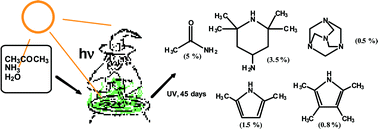A series of prebiotic mixtures of simple molecules, sources of C, H, N, and O, were examined under conditions that may have prevailed during the Hadean eon (4.6–3.8 billion years), namely an oxygen-free atmosphere and a significant UV radiation flux over a large wavelength range due to the absence of an ozone layer. Mixtures contained a C source (methanol, acetone or other ketones), a N source (ammonia or methylamine), and an O source (water) at various molar ratios of C : H : N : O. When subjected to UV light or heated for periods of 7 to 45 days under an argon atmosphere, they yielded a narrow product distribution of a few principal compounds. Different initial conditions produced different distributions. The nature of the products was ascertained by gas chromatographic–mass spectral analysis (GC-MS). UVC irradiation of an aqueous methanol–ammonia–water prebiotic mixture for 14 days under low UV dose (6 × 10−2 Einstein) produced methylisourea, hexamethylenetetramine (HMT), methyl-HMT and hydroxy-HMT, whereas under high UV dose (45 days; 1.9 × 10−1 Einstein) yielded only HMT. By contrast, the prebiotic mixture composed of acetone–ammonia–water produced five principal species with acetamide as the major component; thermally the same mixture produced a different product distribution of four principal species. UVC irradiation of the CH3CN–NH3–H2O prebiotic mixture for 7 days gave mostly trimethyl-s-triazine, whereas in the presence of two metal oxides (TiO2 or Fe2O3) also produced some HMT; the thermal process yielded only acetamide.

You have access to this article
 Please wait while we load your content...
Something went wrong. Try again?
Please wait while we load your content...
Something went wrong. Try again?


 Please wait while we load your content...
Please wait while we load your content...